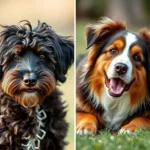
Introduction
When it comes to choosing a dog, understanding the characteristics of different breeds is crucial. Two breeds that often spark interest and debate among potential dog owners are the Pitbull and the Great Dane. Each of these breeds has unique qualities that can influence a person’s decision when considering a new furry family member. This article will delve into their histories, physical characteristics, temperaments, training needs, health considerations, exercise requirements, living conditions, and cost of ownership to provide a clear comparison between the Pitbull and Great Dane.
Breed Histories
Pitbull History
The Pitbull breed has a complex history that traces back to the early 19th century in England, where they were created by breeding bulldogs with terriers. The goal was to develop a dog that combined the strength of the bulldog with the agility and tenacity of the terrier. Initially, Pitbulls were used in bull-baiting, a cruel sport where dogs were set against bulls. After the sport was banned, these dogs were repurposed as farm and family companions.
Over time, Pitbulls became known for their loyalty and affection towards families, particularly children. However, their image has suffered due to media portrayals and misconceptions about aggression. Understanding this breed’s history can help potential owners appreciate the unique qualities and temperament of Pitbulls.
Great Dane History
The Great Dane has a more regal background, originating in Germany as a hunting dog for large game like boar. They were bred from a mix of Mastiffs and Greyhounds, resulting in their impressive size and grace. Historically, Great Danes served as guardians of estates and were symbols of wealth and power, often depicted in art and literature.
As time progressed, the breed transitioned from a working dog to a beloved companion. Their gentle nature and affectionate temperament have made them popular family pets, and they are often referred to as “gentle giants” due to their size and demeanor.
Physical Characteristics
Pitbull Characteristics
Pitbulls are medium-sized dogs, typically weighing between 30 to 85 pounds. They have a muscular build, which gives them a powerful appearance. Their coat is short, smooth, and can come in various colors, including brindle, fawn, black, and blue. Distinctive features of Pitbulls include a broad, square-shaped muzzle, pronounced cheek muscles, and semi-erect ears that may be cropped or left natural. Their athletic build allows for agility and strength, making them well-suited for various activities.
Great Dane Characteristics
In stark contrast, Great Danes are one of the largest dog breeds, often weighing between 110 to 175 pounds. Their height can range from 28 to 34 inches at the shoulder, with some individuals even taller. Great Danes have a short, dense coat that comes in various colors, including fawn, brindle, blue, and harlequin. Their most distinctive feature is their imposing height and elegant stance, complemented by long legs and a rectangular body shape. The ears of Great Danes can be cropped or left natural, and their large, expressive eyes give them a gentle and approachable appearance.
Temperament and Behavior
Pitbull Temperament
Pitbulls are known for their loyalty, energy, and playfulness. They are often described as affectionate dogs that thrive on human interaction. Their protective nature makes them great family companions, but they require proper training and socialization from an early age to minimize any tendencies toward aggression. Pitbulls are intelligent and eager to please, which can make training rewarding, although they can exhibit stubbornness at times.
Their socialization needs are critical; exposure to various environments, people, and other animals helps them grow into well-rounded adults. Responsible ownership and training can help mitigate the breed’s negative stereotypes.
Great Dane Temperament
On the other hand, Great Danes are often referred to as “gentle giants.” They are typically calm, friendly, and affectionate. Despite their size, Great Danes are known for being great with children and other pets, making them excellent family dogs. Their laid-back nature often leads them to be more tolerant and patient than many smaller breeds.
While they may appear intimidating due to their size, Great Danes are usually non-aggressive and social. However, like all breeds, they require socialization to ensure they develop into well-adjusted adults. Their friendly demeanor makes them less likely to have guarding tendencies compared to Pitbulls.
Training and Socialization
Training Pitbulls
Training a Pitbull requires a positive reinforcement approach, focusing on rewards rather than punishment. Consistency is key, as these dogs respond best to structured training environments. Early socialization is crucial for Pitbulls to develop their confidence and reduce any aggressive tendencies. Owners should expose them to various situations, people, and other animals to promote adaptability.
Common challenges in training Pitbulls may include their energy levels and stubbornness. Engaging them in regular obedience classes can help address these issues and provide them with the mental stimulation they need.
Training Great Danes
Training a Great Dane also requires patience and consistency. Their size can be intimidating, but they respond well to calm and assertive training methods. Given their gentle and affectionate nature, Great Danes are often eager to please, which makes them relatively easy to train.
Socialization is equally important for Great Danes; exposing them to different environments and experiences helps them become well-rounded dogs. Potential challenges in training may include their size, which can make them difficult to manage if they pull on the leash. Training should focus on leash manners and basic commands to ensure they develop into well-behaved companions.
Health Considerations
Common Health Issues in Pitbulls
Pitbulls are generally healthy dogs, but they can be prone to certain genetic health issues. Common concerns include hip dysplasia, skin allergies, and heart conditions. The average lifespan of a Pitbull ranges from 12 to 16 years, and prospective owners should budget for regular veterinary care, which can average around $300 to $500 annually, depending on health needs.
Common Health Issues in Great Danes
Conversely, Great Danes face several health challenges due to their large size. They are particularly susceptible to bloat, a life-threatening condition that requires immediate veterinary attention. Other common health issues include hip dysplasia and heart conditions such as dilated cardiomyopathy. The average lifespan of a Great Dane is shorter, typically around 7 to 10 years, and owners should expect annual veterinary costs to be higher, often ranging from $500 to $1,000.
Exercise and Activity Needs
Pitbull Exercise Requirements
Pitbulls are energetic and active dogs that require substantial exercise to stay healthy and happy. Owners should aim for at least 60 minutes of exercise daily, which can include walks, runs, and playtime in a secure yard. Activities such as agility training, fetch, and swimming can also be enjoyable for Pitbulls. Mental stimulation is equally important, so incorporating puzzle toys or training games can help keep them engaged.
Great Dane Exercise Requirements
While Great Danes require less intense exercise compared to Pitbulls, they still need daily activity to maintain their health. A moderate 30 to 60 minutes of exercise is typically sufficient, which can include leisurely walks and play sessions. Due to their size, it’s essential to avoid overexertion, especially in hot weather. Gentle activities that promote bonding, such as light fetch or obedience training, are excellent options for keeping Great Danes active without straining their joints.
Living Conditions
Ideal Living Situations for Pitbulls
Pitbulls can adapt to various living situations, from apartments to houses, as long as they receive enough exercise. However, they do best in environments where they have space to play and explore. A home with a securely fenced yard is ideal for this breed, allowing them to roam safely. Families with children often find Pitbulls to be loving and protective companions.
Ideal Living Situations for Great Danes
Given their size, Great Danes require more space than Pitbulls and are better suited for homes rather than apartments. A large house with a yard is ideal, as these dogs enjoy having room to move around. Despite their size, Great Danes are known for being gentle and adaptable, making them excellent companions for families and individuals alike. Their affectionate nature allows them to thrive in loving households where they can receive plenty of attention.
Cost of Ownership
Financial Considerations for Pitbull Owners
When considering a Pitbull, initial costs can vary, typically ranging from $100 to $1,500 for adoption or purchase. Supplies such as food, grooming, and training can average around $500 annually, with potential veterinary costs adding another $300 to $500. Overall, prospective Pitbull owners should budget approximately $800 to $2,500 in the first year, with lower ongoing costs in subsequent years.
Financial Considerations for Great Dane Owners
On the other hand, owning a Great Dane can be more expensive due to their size. Initial costs may range from $1,000 to $3,000, with food and grooming expenses significantly higher than smaller breeds. Annual veterinary care can average between $500 and $1,000, leading to total initial costs of around $1,500 to $4,000 in the first year. Given their shorter lifespan, potential owners should be prepared for these financial commitments.
Conclusion
In summary, both the Pitbull and the Great Dane have unique characteristics and qualities that make them appealing to various dog owners. Pitbulls are loyal, energetic, and protective companions, while Great Danes are gentle giants known for their calm and affectionate nature. When choosing between these two breeds, potential owners should consider factors such as temperament, exercise needs, living conditions, and financial responsibilities.
Regardless of the breed, individual dog personalities can vary significantly, and understanding the unique traits of each dog is crucial for a successful and fulfilling relationship. The joys of dog ownership extend beyond breed stereotypes, offering love, companionship, and countless memorable moments.









